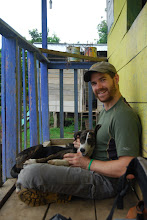Some 70-40 million years ago Colorado, and much of today's U.S. was a vast inland ocean, covering the majority of the country. But a hotspot was forming beneath the earth's crust as a continental plate to the south of North America subducted and melted, creating great pressure just beneath the surface of this ocean. What has become known as the Laramide Orogeny (meaning uplifting) was essentially no more than a massive blister on the surface of the earth, that erupted. Massive volcanoes rose out of the ocean as the sea level fell away from the whole continent. These volcanoes have since eroded, leaving only their granitic roots exposed within the heart of the Rockies. Over millions of years, the seabed turned to a hard crust beneath the weight of ocean. This plastic crust bent upwards as this volcanic blister rose from the depths of the earth. Over many years, these sandstone rocks were heated to high enough temperature for long enough times to change their composition, or metamorphose them the same way we heat sand up to change it into glass.
The foothills and flatirons are the relics of these ancient seabeds that were bent up into the sky as the rockies rose up from beneath them. This creates little ridges all over the foothills where one side (the southern side) gets bathed in sun all day long, while the other side (the northern side) receives almost no direct sunlight. As lichens grow communities on these bare rocks and invite other organisms to the new community, soils begin to form in the crevices of the aging rocks, and over time the soil gets deep enough to support fields and even forests. This is where the amazing things happens.
The term microclimate refers to, a specific climate that exists within a specific area. So, while the general temperature along the front range today is currently 55 degrees F, the northern shaded side of these ridges may be 40 or 45 degrees F, while the sunny southern side may be close to 70 degrees F. This creates massive differences when you take seasonal weather extremes into consideration.

So, in this photo above, you can see where the northern side of the slope to the right still maintains snowcover from over a week ago, while the sunny southern side to the left of the photo is completely void of snow. This speed at which this snow melts on either side of the slope creates huge temperature and relative humidity differences on a daily basis, and the vegetation bears witness to this. The left side of the photo shows rocks, ponderosa pines, and short grass and succulent species, while the right side of the photo clearly shows higher density of ponderosa pine, and taller scrub oak and other shrubby species. It is amazing to sit around and witness the ways the animals that live in these foothills have adapted to these diverse microclimates. We are still slowly learning their adaptations. Take deer for one example.
Deer sleep in the cover of the higher shrubs, and graze on the vegetation of the drier areas during the day. That is all cool, but what blows me away is how they affect the landscape.
Most people are aware of the ancient Inca populations that lived high in the mountains, and terraced their lands so that they could still perform agriculture without rain eroding their bare slopes during tilling and planting times. Do you think they learned this through an epiphany one day? NO! Alpaca and other llama like species graze these alpine hillsides, and over generations, their trails form mini-terraces, perhaps 3-6 inches wide. Our deer to the same exact thing. Year after year, they form trails that run parallel to their older trails. This minimizes the impact over any one area, and at the same time also improves the ability of the land to stand up to severe weather! Below is a photo I tried to manipulate to show these terraces on the hill. The youngest trails reflect light the best. I haven't gotten a really good picture of this yet, but if you see the whitish lines in the middle of the photo that go up and down, these are the terrace-like trails formed by the deer of the foothills.

I know this photo isn't the best yet, but how amazing is that?!


2 comments:
Whenever there is a light snow, it is easy to pick out the parallel trails along hill banks. It always amazes me how many there are...
At the same time, I have seen plenty of game trails leading directly up steep hills, obviously contributing to erosion. Maybe not all deer have mastered the switchback...
Have you mastered the switchback Silas?
I wonder if all of those trails you see going uphill were started by deer, or another, bipedal animal?
See you soon.
Post a Comment